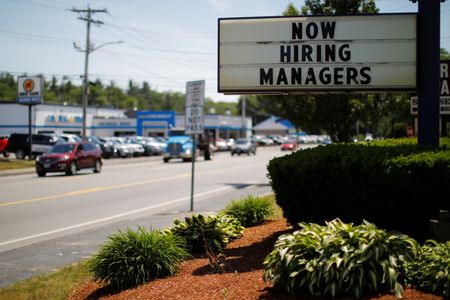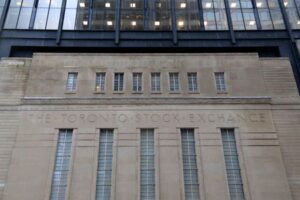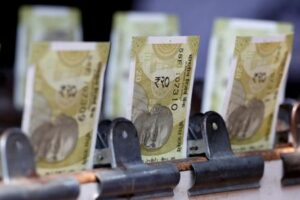By Lindsay Dunsmuir
(Reuters) -The number of Americans filing new applications for unemployment benefits ticked up in the latest week, but appeared to be steadying near a level consistent with a gradual cooling of the labor market that should set the stage for the Federal Reserve to kick off interest rate cuts next month.
A slowdown in overall U.S. business activity this month as firms faced diminished ability to push through price increases added to the evidence that the economy is slowing and inflation is downshifting to a degree that should allow Fed officials to focus more attention on the job market.
With a rate cut now broadly expected next month, interest rates on home loans have already begun dropping, and that helped fuel a larger-than-expected rebound in existing home sales last month.
Initial claims for state unemployment benefits rose 4,000 to a seasonally adjusted 232,000 for the week ended Aug. 17, the Labor Department said on Thursday. Economists polled by Reuters had forecast 230,000 claims for the latest week.
The latest data should continue to allay fears that the labor market is rapidly deteriorating, first raised after a sharper-than-expected slowdown in job growth in July, which also saw the unemployment rate rise to a post-pandemic high of 4.3%.
Indeed, the latest claims data covers the survey week for this month’s employment report from the Labor Department, and the leveling off in new filings points to “a small decline in the unemployment rate in August,” Nancy Vanden Houten, lead U.S. economist at Oxford Economics, said in a client note.
“Claims are leveling off on a trend basis, consistent with our view that, while the labor market is softening, it isn’t weak enough to warrant anything more than a 25 (basis point) rate cut at the Fed’s September meeting,” she said.
Fed officials have said they are keenly watching the labor market, aware that waiting too long to cut interest rates could cause serious harm.
Layoffs remain historically low, however, with much of the slowdown in the labor market coming from firms scaling back hiring, trailing an immigration-induced surge in labor supply.
The Fed’s 525 basis points worth of rate hikes in 2022 and 2023 are curbing demand.
The U.S. central bank has kept its benchmark overnight interest rate in the current 5.25%-5.50% range for more than a year. With a first rate cut now widely expected at its Sept. 17-18 policy meeting, the market focus is on how large a reduction it will be – a quarter or a half percentage point.
The number of people receiving benefits after an initial week of aid, a proxy for hiring, rose 4,000 to a seasonally adjusted 1.863 million during the week ending Aug. 10, the claims report showed.
GROWTH STILL SOLID
The report on business activity also pointed to an orderly cooling in the economy. S&P Global said on Thursday that its flash U.S. Composite PMI Output Index, which tracks the manufacturing and services sectors, edged down to 54.1 this month, a four-month low but still healthy level among the highest measured over the past two years. That followed a final reading of 54.3 in July.
A reading above 50 indicates expansion in the private sector. A slight pick-up in the services sector was outpaced by an easing in the manufacturing industry.
Average prices charged for goods and services rose at the slowest rate since January and echoed reports from businesses that customers are pushing back against high prices, through bargain-hunting, scaling back on purchases and trading down to lower-priced substitutes.
The nearly unchanged composite PMI implied that economic activity remained on a solid footing as the third quarter progressed. Gross domestic product increased at a 2.8% annualized rate in the second quarter, picking up from the January-March quarter’s 1.4% pace.
“The solid growth picture in August points to robust GDP growth in excess of 2% annualized in the third quarter, which should help allay near-term recession fears,” said Chris Williamson, chief business economist at S&P Global Market Intelligence. “Similarly, the fall in selling price inflation to a level close to the pre-pandemic average signals a ‘normalization’ of inflation and adds to the case for lower interest rates.”
The survey’s measure of new orders received by private businesses edged up to 52.3 from 52.2 in July. Its measure of prices paid by businesses for inputs was unchanged at 58.0, but the survey’s gauge of prices charged slipped to 52.8 from 53.1 in July.
Meanwhile, U.S. existing home sales rose more than expected in July, reversing four consecutive monthly declines, as improving supply and declining mortgage rates offered hope that activity could rebound in the months ahead.
Home sales rose 1.3% last month to a seasonally adjusted annual rate of 3.95 million units, the National Association of Realtors said on Thursday. Economists polled by Reuters had forecast home resales would edge up to a rate of 3.93 million units.
Home resales, which account for a large portion of U.S. housing sales, declined 2.5% on a year-on-year basis in July. The median existing home price jumped 4.2% from a year earlier to $422,600. Inventory rose 0.8% to 1.33 million units last month while supply jumped 19.8% from one year ago.
(Reporting by Lindsay Dunsmuir and Dan Burns; Editing by Chizu Nomiyama and Paul Simao)





